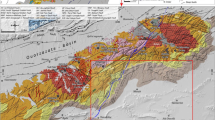Abstract
Based on studies of regional tectonic setting and the observation of drilling cores, the seismite is recognized in member III at Shahejie Formation in the Xianhe area of the Dongying sag. The principal mark of the seismite is the development of all kinds of soft sedimentary deformation structures, such as micro-step fault, intraformational minor fold, deformation, vibrational liquefied sandstone dike and seismic breccias. By observing the drilling cores of He 152, Wang 59, Niu 38, Niu 22 and so on, we found that the vertical sequences of the seismite are different because of the differences in structure and seismic intensity. We also found that different seismite structures are formed by different seismic intensities and that the relationships between seismite structures and paleoearthquakes were further confirmed by studying the relationship between all kinks of seismite structures and seismic intensity. Researches on reservoirs show that seismite can be an effective reservoir. These researches provide an important geological theoretical foundation for the study of the tectonic evolution of the Dongying sag and for seismite identification and description, and also supplies evidence for the researches of paleoearthquakes.
Similar content being viewed by others
References
Cao G Q, Chen S Y, Yan J H, et al (2004). The Early Tertiary sedimentary sequence of earthquake events in Jiyang depression. Geology Exploration Commention, 19(4): 252–256 (in Chinese with English abstract)
Chen S Y, Yuan W F, Yan J H, et al (2003). Discovery and significance of earthquake event deposits of Early Tertiary in the Jiyang depression. Chinese Journal of Geology, 38(3): 413–424 (in Chinese with English abstract)
Du Y S, Han X (2000). Study on seismite action and seismite. Advances in Earth Science, 15(4): 389–394 (in Chinese with English abstract)
Guo J H, Wang F P, Liu G, et al (1999). Shattered breccia of the Upper Sinian Dengying Formation in Dayong, West Hunan Province. Petroleum Geology and Experiment, 21(3): 219–224 (in Chinese with English abstract)
Heezen B C, Dyke C L (1964). Grand bank slump. Bull Am Ass Petrol Grol, 48(2): 221–225
Liang D Y, Nie Z T, Song Z M, et al (1994). A re-study on seisnite and seismite-unconformity. Earth Science—Journal of China University of Geosciences, 19(6): 845–851 (in Chinese with English abstract)
Plaziat J C, Ahmamou M (1998). Mechanic processes active in seismites: Their identification and tectonic significance in the Pliocene basin of the Sais of Fes and Meknes. Geodynamic Acta, 11(4): 183–203
Qiao X F (1996). Study of seismites of China and its prospects. Geol Rev, 42(4): 317–320 (in Chinese with English abstract)
Qiao X F, Song T R, Gao L Z, et al (1994). Seismic sequence in carbonate rocks by vibrational liquefaction. Acta Geologica Sinica, 68(1): 16–32 (in Chinese with English abstract)
Smith A G (1968). The origin and deformation of some “molar tooth” structure in the Precambrian belt Purcel Super Group. Journal of Geology, 76(4): 426–443
Song T R, He Z J, Ding X Z, et al (1988). A possible seismic-tsunami sequence in Precambrian carbonate stratigraphy in Shisanling area, Beijing. Chinese Sci Bull, 38(8): 609–611 (in Chinese)
Tian H S, Wang J G, Lu M Y, et al (2005). Seismic records in Paleogene alluvial layers in Anqiu, Shangdong. Acta Sedimentological Sinica, 23(3): 447–453 (in Chinese with English abstract)
Wu X T, Yin G X (1992). Features and significance of seismite from Upper Jurassic lacustrine deposits of Emei, Sichuan Province. Acta Sedimentologica Sinica, 10(3): 19–24 (in Chinese with English abstract)
Yang J P, Wang H, Chen S Y, et al (2004). The features of seismites in Jiyang sub-basin, Paleogene. Acta Sedimentologica Sinica, 22(2): 281–287 (in Chinese with English abstract)
Yuan J (2004). The property and geological significance of seismites of Paleogene in Huimin sag, Shandong Province. Acta Sedimentological Sinica, 22(1): 41–46 (in Chinese with English abstract)
Author information
Authors and Affiliations
Corresponding author
Additional information
__________
Translated from Acta Sedimentologica Sinica, 2006, 24(6): 798–804 [译自: 沉积学报]
Rights and permissions
About this article
Cite this article
Wei, C., Zhang, S., Jiang, Z. et al. Characteristics and significance of seismite of Silurian in member III at Shahejie Formation. Front. Earth Sci. China 1, 505–513 (2007). https://doi.org/10.1007/s11707-007-0062-x
Issue Date:
DOI: https://doi.org/10.1007/s11707-007-0062-x



